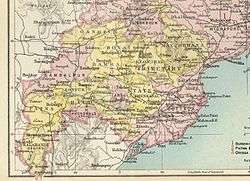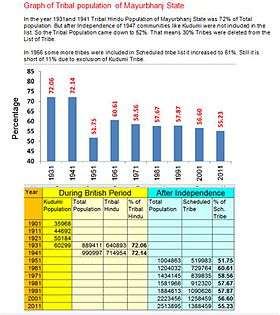Mayurbhanj State
| Mayurbhanj State ମୟୂରଭଞ୍ଜ | |||||
| Princely State of British India | |||||
| |||||
|
Flag | |||||
 | |||||
| History | |||||
| • | Established | Late 17th century | |||
| • | Accession to the Union of India | 1949 | |||
| Area | |||||
| • | 1901 | 10,982 km2 (4,240 sq mi) | |||
| Population | |||||
| • | 1901 | 610,383 | |||
| Density | 55.6 /km2 (144 /sq mi) | ||||
| Today part of | Odisha, India | ||||
| | |||||


Mayurbhanj State, was one of the princely states of India during the period of the British Raj. It was one of the largest states of the Eastern States Agency and one of the three states of the Bengal States Agency. The emblem of the state were two peacocks for according to legend the ancestors of the ancient rulers originated from a peafowl's eyes.[1]
The state included a vast mountainous area inhabited by many different people groups such as the Santal, Ho and Kisan people.[2] Its former territory lies in the present-day state of Odisha, bordering West Bengal. The capital of the state was the town of Baripada since the 15th century and Daspur was another important town. Large tracts of Mayurbhanj State were covered with forest.
History
Early history
According to tradition the kings of Khijjinga Mandala, the predecessor state, had ruled in unbroken succession since about the 9th century AD. The state had been named after its capital, Khijjinga Kotta, today Khiching. Copper plate inscriptions issued by the ancient rulers indicate that Khijjinga Mandala was an extensive territory comprising the present Mayurbhanj and Kendujhar districts as well as parts of Singhbhum district in Bihar and Midnapore district in West Bengal. During the Mughal period, the territory of the Bhanja rulers extended as far as the Bay of Bengal. By that time, the capital had shifted from Khijjinga Kotta to Haripur. The ruins of the temples and palaces built then can be found at Haripur about 16 km southeast of Baripada. Among the ruins, the Rasikaraya temple and the Durbar hall of the Bhanj kings are the most significant.
The rulers were Rajputs of the Bhanj dynasty,[3] tradition saying that since the mythical founder Sila Bhanja Angaddi they were the longest reigning clan of monarchs in the area.[4] Since they very good relations with the Mayur kings of Kendujhar, the Mayurs and the Bhanjas joined and gave origin to the name of the state.
The Bhanj rulers were promoters of art, architecture and culture. The Hari Baladev Jiu Temple, the Khichhing temple and other architecture in and around the district stand testimony to this. Also the royal family was responsible for the development and promotion of the Chhau dance form which integrates martial, tribal and classical elements.[5]
British rule
Mayurbhanj State had been under Maratha rule during the 18th century and became a British protectorate in 1829, many years after the Third Anglo-Maratha War. During the British Raj the kings of Mayurbhanj pioneered the upliftment of the region. Under their enlightened rule Mayurbhanj became one of the most progressive areas. The Bhanj kings established the first medical college of the state in Cuttack, donating funds and land for the establishment of higher education institutions such as Ravenshaw College and welfare schemes, such as the one undertaken by the Evangelical Missionary Society of Mayurbhanj (EMSM), established in 1895 at the instance of Maharaja Sriram Chandra Bhanj Deo.[6] Mayurbhanj Palace was built by Maharani Sumitra Devi Bhanj Deo in 1804.[7]
The Mayurbhanj State Railway was started by the erstwhile ruler of Mayurbhanj Maharaja Shri Sriram Chandra Bhanj Deo. The first section of 52 km from Rupsa to Baripada railway station being opened for traffic on 20 January 1905.[8]
The last ruler of this princely state signed the accession to the Indian Union on 1 January 1948. After the independence of India, Mayurbhanj state under Maharaja Pratap Chandra Bhanjdeo acceded to the Indian Union on 1 January 1949 and was merged with Orissa Province, which became later the state of Odisha.
Rulers
The rulers of Mayurbhanj State bore the title of 'Raja' from mid 19th century and the title of 'Maharaja' from 1910 until the last head of the state.[9] They were entitled to a 9 gun salute.[10]
Early rulers
- 1688 - 1711 Savesvara Bhanj Deo
- 1711 - 1728 Viravikramaditya Bhanj Deo
- 1728 - 1750 Raghunath Bhanj Deo
- 1750 - 1761 Chakradhar Bhanj Deo
- 1761 - 1796 Damodar Bhanj Deo
- 1796 - 1811 Sumitra Devi (f) -Rani
- 1811 - 1822 Tribikram Bhanj Deo (d. 1822)
- 1811 - 1813 Rani Jamuna Devi (f) -Regent
- 1822 - 18.. Jadunath Bhanj Deo (d. 1863)
Rajas
- 18.. - 1863 Jadunath Bhanj Deo (s.a.) (personal style of Maharaja)
- 1863 - 1868 Shrinath Bhanj Deo (d. 1868)
- 1868 - 29 May 1882 Krishnachandra Bhanj Deo (b. 1848 - d. 1882) (from 1877, personal style of Maharaja)
- 29 May 1882 - 1910 Sriram Chandra Bhanj Deo (b. 1871 - d. 1912) married Maharani Sucharu Devi
- 29 May 1882 - 15 Aug 1892 .... -Regent
Maharajas
- 1910 - 22 Feb 1912 Ramchandra Bhanj Deo (s.a.)
- 22 Feb 1912 - 21 Apr 1928 Purnachandra Bhanj Deo (b. 1899 - d. 1928)
- 22 Feb 1912 - 21 Apr 1928 .... -Regent
- 21 Apr 1928 - 15 Apr 1947 Pratapchandra Bhanj Deo (b. 1901 - d. 1968) (from 1 Jan 1935, Sir Pratapchandra Bhanj Deo)
See also
- Mayurbhanj Palace
- Mayurbhanj State Railway
- Shri Ramachandra Bhanj Medical College
- Eastern States Agency
- Khandayat
- Political integration of India
References
- ↑ Imperial Gazetteer of India, v. 17, p. 242.
- ↑ The Tribes and Castes of the Central Provinces of India
- ↑ Rajput Provinces of India - Mayurbhanj (Princely State)
- ↑ Minor States in The Deccan - Early Bhañja Family, p. 498
- ↑ Untold Stories of 1st Responsible Govt. of Mayurbhanj
- ↑ Special Report at Hindu Vivek Kendra website
- ↑ Family tree of Ruler of Mayurbhanj according to palm manuscript
- ↑ Malleson, G. B.: An historical sketch of the native states of India, London 1875, Reprint Delhi 1984
- ↑ Princely States of India
- ↑ Mayurbhanj Princely State (9 gun salute)
External links
Coordinates: 21°56′N 86°43′E / 21.94°N 86.72°E
